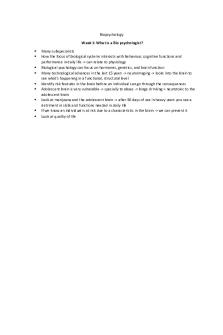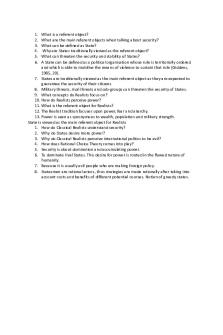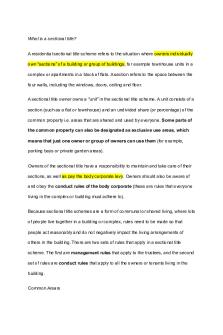Correct What is a neurovascular assessment and how PDF

| Title | Correct What is a neurovascular assessment and how |
|---|---|
| Course | Promoting Health in Extended Care |
| Institution | Australian Catholic University |
| Pages | 7 |
| File Size | 490.8 KB |
| File Type | |
| Total Downloads | 72 |
| Total Views | 146 |
Summary
Neurovascualar assessment and how it relates to compartment syndrome...
Description
What is a neurovascular assessment and how & why is this carried out on Matt? Today we will be doing a neurovascular assessment Steven will act as “Matt” and I will act as the Nurse for this scenario.
http://www.thebrainandspine.com/wp-content/uploads/2014/02/Neurovascular-Surgery.gif
A neurovascular assessment is series of evaluations with a purpose to recognise early vascular and nervous system defects in an attempt to prevent permanent damage to a limb. [ CITATION The15 \l 1033 ] The reasons that this is carried out on Matt is due to his condition is of an open fracture of his right proximal tibia and fibula which is a high risk of permanent damage in his right lower leg. And the fact that he is scheduled for surgery for his limb and requires a baseline prior to it.
http://www.mjdrdypu.org/viewimage.asp?img=MedJDYPatilUniv_2013_6_3_294_114655_f1.jpg
First things first you will need a neurovascular assessment. Collecting your equipment before going through the procedure portrays confidence and allows yourself to look reliable for your patient.
https://www.onlinewebfonts.com/icon/493728
And of course, make sure to wash your hands before this procedure to deny the spread of micro-organisms. https://www.abqjournal.com/1088998/microbes-getting-moreattention.html/b05_jd_07nov_microbes
https://vimeopro.com/tafe/diploma-of-nursing-in-house-videos/video/169176291 Assessing Matt’s leg distal to the injury will help find the extent of damage with neurological or vascular function. The Nerve assessment will evaluate for sensation and mobility. Vascular assessments will assess for colour, temperature, capillary refill and pulses. Differentiating between the damaged limb and undamaged limb will provide evidence to what is normal or unusual for Matt. This will be done usually hourly for Matt as this is post-trauma. ----------------------------
What we are trying to catch early for Matt is Compartment Syndrome. Compartment Syndrome is when pressure in the affected muscle surges to unsafe stages and blood flow becomes insufficient. This negates blood carrying vital nutrients and oxygen from arriving to nerves and muscles cells. From there permanent damage of the cells could occur. There are two types of compartment syndrome, one of them is chronic compartment syndrome, this is due to athletic exertion. But more relatable is the other, Acute compartment syndrome this is can be due to serious injury such as a fracture like Matts. [ CITATION Ama17 \l 3081 ] https://c7npsfqifvt34x24jnbhftx2enfejdjofofux2edpn.g00.medicinenet.com/g00/3_c7x78x78x78.nfejdjofofu.dpn_/c7NPSFQIFVT34x24iuuqtx3ax2fx2fjnbhft.nfejdjofofu.dpnx2fjnbhftx2fjmmvtusbujpotx2f3122dpnqbsunfou-tzoespnf.kqhx3fj21d.nbslx3djnbhf_$/$/$/$
Pain level: Foremost we will ask Matt about the pain in his right proximal tibia. Pain is the earliest sign and dependable symptom for compartment syndrome. Moderate pain is completely normal with analgesia. But severe pain beyond in comparison to Matt’s injury that is unrelieved despite repositioning or elevation or even by use of narcotic analgesic is a crucial symptom for compartment syndrome. If Matt is suffering from this type of pain, and he feels an abnormal sensation like tingling or prickling and paralysis of the limb, this requires immediate action within four hours to prevent damage.
https://www.myfootdr.com.au/wp-content/uploads/leg-pain-feet-shin-splints-calf-strain-ankle-paininjury-shutterstock-440535319.jpg
Colour: For healthy skin, pink is the for healthy individuals.For Matt we are looking for signs of Compartment syndrome in colour are pale which is an indication of lack of blood flow, redness and cyanosis which is the lack of oxygen in the skin. http://3.bp.blogspot.com/Iu1sI4cUvIQ/TfDN3uiNBpI/AAAAAAAAAHQ/Mccx0MGTapA/s1600/differential+cyanosis.jpg
Temperature: For normal temperature the limb should be warm to touch like the temperature similar to unaffected limbs. Signs compartment syndrome would be if the limb is cold or hot to the touch. http://jewel1067.com/wp-content/uploads/hotcold.jpg
Normal
Delayed
https://www.monroecc.edu/depts/pstc/ems/paramedic/paramedic-training-at-mcc/degreeprogram-content/capillary-refill/ Pulses- Pulses in comparison to an unaffected limb should be in the same rate. If pulses blocked due to being under cast or other situations, assess the capillary refill. Capillary refills should be less than 3 seconds. Although it is noted that capillary refills and pulses are considered to be unreliable in signs of compartment syndrome as it may be absent or may remain normal.
https://www.rch.org.au/rchcpg/hospital_clinical_guideline_index/Neurovascular_observations/
For Sensation we will ask Matt to close their eyes and we want him to identify sensations amongst the different areas of skin. These diagrams are available in most neurovascular assessment charts like this one. And again, as mentioned before we will ask Matt about any abnormal feelings of tightness, numbness, tingling and so forth as this may relate to compartment syndrome.
Motor function – This is where we will request Matt to move accordingly following the instructions showed in the neurovascular sheet. Limbs that are unaffected should be able to perform these tasks. However, if Matt struggles, and show signs of muscle weakness or incapacity to flex or spread his extremities this is a late symptom of compartment syndrome and may have already caused permanent damage.
http://www.harmony-healthcare.com/hs-fs/hubfs/nursesigndocs.jpg? t=1522780247399&width=275&name=nursesigndocs.jpg Documentation- Observations are recorded of course in our neurovascular evaluation sheet. The state of Matt’s neurovascular ability is noted here once per shift. It cannot be stressed enough for the sake of Matt, that compartment syndrome must be searched for in every assessment and must be reported immediately once signs are shown.
Bibliography Amanda Barrell Barrel, A. (2017, July 26th). Compartment syndrome: Anatomy, causes, and treatment. Retrieved March 20th, 2018, from MedicalNewsToday: https://www.medicalnewstoday.com/articles/318581.php Clinical Psychomotor Skills (5th ed.). (2012). South Melbourne, Victoria, Australia: Cengage Learning Australia. Retrieved March 19th, 2018 The Royal Children's Hospital Melbourne. (2015, January N/A). Neurovascular observations. Retrieved March 17th, 2018, from The Royal Children's Hospital Melbourne: https://www.rch.org.au/rchcpg/hospital_clinical_guideline_index/Neurovascular_observatio ns/...
Similar Free PDFs

Neurovascular Assessment Notes
- 6 Pages

What is a Biopsychologist
- 1 Pages

What is a myth and chronology
- 2 Pages

What is a referent object
- 1 Pages

What is a social fact
- 2 Pages

What is ABA - Grade: A
- 5 Pages

What is race - Grade: A
- 1 Pages

What is a sectional title
- 4 Pages

What is a summary judgement
- 5 Pages

What is a product - lecture
- 4 Pages
Popular Institutions
- Tinajero National High School - Annex
- Politeknik Caltex Riau
- Yokohama City University
- SGT University
- University of Al-Qadisiyah
- Divine Word College of Vigan
- Techniek College Rotterdam
- Universidade de Santiago
- Universiti Teknologi MARA Cawangan Johor Kampus Pasir Gudang
- Poltekkes Kemenkes Yogyakarta
- Baguio City National High School
- Colegio san marcos
- preparatoria uno
- Centro de Bachillerato Tecnológico Industrial y de Servicios No. 107
- Dalian Maritime University
- Quang Trung Secondary School
- Colegio Tecnológico en Informática
- Corporación Regional de Educación Superior
- Grupo CEDVA
- Dar Al Uloom University
- Centro de Estudios Preuniversitarios de la Universidad Nacional de Ingeniería
- 上智大学
- Aakash International School, Nuna Majara
- San Felipe Neri Catholic School
- Kang Chiao International School - New Taipei City
- Misamis Occidental National High School
- Institución Educativa Escuela Normal Juan Ladrilleros
- Kolehiyo ng Pantukan
- Batanes State College
- Instituto Continental
- Sekolah Menengah Kejuruan Kesehatan Kaltara (Tarakan)
- Colegio de La Inmaculada Concepcion - Cebu





